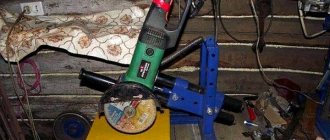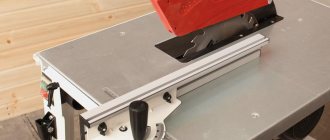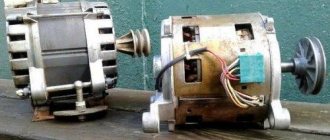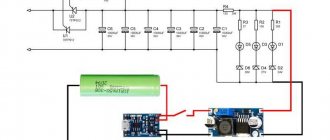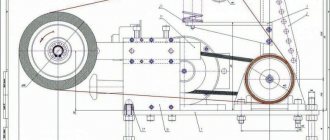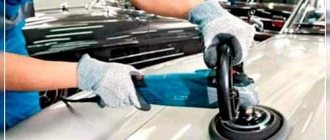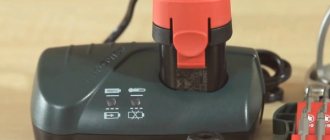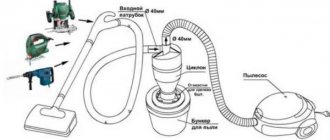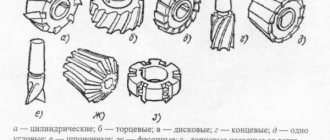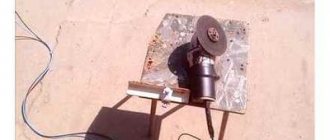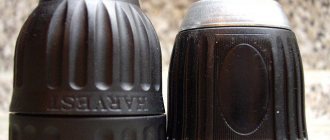Causes of dust formation
The grinder is a universal tool.
With its help, using various attachments, you can cut metal, stone, porcelain stoneware and tiles, process wood and other materials. But one of the disadvantages is the formation of a huge amount of dust. Work that causes the formation of large amounts of small debris:
- Grooving grooves on walls. The work is carried out using plaster, and cement and sand have a fine fraction. The height of the passage of the channels is at the level of one and a half or two meters. From such a height, dust settles evenly over the entire area of the room.
- Sanding of wooden structures. Before painting or varnishing, wooden products must be removed from the cellulose fibers that form during the sawing process. Cellulose is thin, light and hangs in the air for a long time.
- Removing old paintwork. Before applying fresh paint, the old paint must be removed. A flap sanding wheel is used. The paint it removes is fine.
- Cutting floor and decorative ceramic tiles. Sintered ceramic has a fine grain structure and it penetrates everywhere.
- Sanding parquet or wooden floors. Floor leveling occurs by removing the top layer. The irregularities have different heights and therefore, in addition to shavings, a lot of wood dust is formed.
Upon completion of the repair, dust must be removed from all possible cracks and cavities. To protect adjacent rooms from construction dust, protective screens made of polyethylene film or light fabric are installed in doorways. Special devices are also used that you can make yourself.
How to make a nozzle with your own hands
The following are videos demonstrating the process of making a casing for an angle grinder with your own hands. Craftsmen use various materials and technologies for production.
Homemade for gating, for a vacuum cleaner
Dust extraction covers are the most popular type.
Homemade protective casing for a diamond bowl from a plastic stand, corner and clamp
The base for the cover is a plastic stand for a flower pot.
A hole is made in the center: several cuts are made, the workpiece is heated and the edges are moved back.
A hole is formed at the edge for the PVC corner, which is then attached by soldering to the stand.
It is recommended to cover the rim with thick fabric or foam rubber to trap debris.
Casing made of a plastic bowl, pipes with a diameter of 40 mm. and clamp
To make it you will need a plastic cup and a pipe with a diameter of 40 mm. and a clamp.
A hole is drilled in the center of the bowl using a drill, “petals” are cut, and the edges are moved back by placing a pipe in the hole.
The workpiece is tried on a drill, the “petals” are cut off a little.
Using a clamp, the workpiece is attached to the angle grinder and made smaller in height; unnecessary parts are removed with scissors.
To make a dust extractor, another hole is made. The pipe is attached to the workpiece using wire stitching, and the joint is coated with silicone.
On the inside, the edges of the cover are covered with double-sided tape and door tape, which will keep dust out.
Upgrading the metal casing with a dust extractor and a curtain to adjust the cutting depth
Two plates of a similar shape are welded to the metal casing, thereby providing greater protection to the nozzle.
A hole is formed on the cover, a tube with a diameter of 25 mm is welded, i.e. dust removal is done.
There will also be a movable plate on the bottom side of the nozzle, which is secured using a curtain welded to one of the sides.
On the other side, a plate with holes for a bolt is attached. It is used to adjust the cutting depth.
Types of casings
In stores selling electric tools you can find a protective casing for angle grinders with a dust extraction. Most manufacturers make them for semi-professional and professional equipment from well-known companies.
The purpose of this additional equipment is to effectively remove dust from the processing area using the grinder itself. Fastening is carried out in regular places using a clamp.
The exhaust pipe is the same size as the suction hose of a vacuum cleaner. Outer diameter - 65 mm. The hole diameter is 59 mm. The dimensions of the dust extractor correspond to the circle being installed. For example, the Messer 10−40−441 casing is designed for a circle with a diameter of 180 mm. And its dimensions are 245x230x100 mm.
The big disadvantage of purchased equipment is the high price. Thus, the minimum cost for an exhaust hood for an angle grinder for a vacuum cleaner ranges around 3,000 rubles, which is comparable to the cost of a budget angle grinder.
But the need for invention is tricky, and home craftsmen solved the problem by independently manufacturing additional equipment.
How to use an angle grinder: tips and tricks from experts
The manufactured attachment on the grinder not only eliminates the formation of dust, but also acts as an additional protection for humans from the negative effects of power tools. An angle grinder is a life-threatening tool that is used for a variety of tasks. It is important to follow safety precautions when performing these tasks to prevent injury or injury.
Experts recommend following a number of the following recommendations when working with power tools:
- Hold the instrument with two hands only
- Use only suitable cutting discs and wheels depending on the materials being processed
- Do not get carried away with wood processing using an angle grinder. An angle grinder for working with wood is not the best option
- Carry out work in protective clothing - goggles, respirator, gloves, etc.
- Pause periodically to allow the instrument to cool down.
- When using a casing, it is necessary to ensure that it is tightly fixed to the power tool. If it vibrates, it may fall under the rotating disk and be damaged.
To make a homemade casing for an angle grinder to connect a vacuum cleaner, you will need to show a little ingenuity and imagination. Making a device is not at all difficult, and you just need to choose the right material to use as a basis. It can be not only plastic or metal, but also wood, for example, chipboard or fiberboard. And at the same time, you don’t need to buy a homemade device in order to ultimately carry out one-time work on processing concrete, wood or tiles with an angle grinder.
Self-production
Making a casing for an angle grinder for a vacuum cleaner with your own hands is not difficult. You just need to approach the problem with imagination. There are many materials for manufacturing:
- aluminum pan or plate;
- plastic oil canister;
- plastic bottle with a volume of 5 liters.
The best option is considered to be one that does not require the use of a welding machine.
Standard casing
A less expensive manufacturing method is to use a standard protective device. You only need to attach the side cover and pipe to it. To make a side cover, you can take a piece of galvanized steel and then proceed like this:
- Cut strips of galvanized steel 15 mm wide and 30 mm long to make corners. Then bend them at a right angle in the middle.
- In the side open part of the casing, drill holes with a diameter less than the thickness of the screws. Fasten the previously made corners through these holes.
- Cut out the side cover from galvanized steel along the contour.
- Drill a hole in it closer to the edge for the pipe.
- The pipe can be made by rolling a sheet blank into a pipe. The edges can be secured together with self-tapping screws or clamps.
- One edge of the pipe must be cut in several places. And straighten these sectors.
- Insert the pipe into the cut-out cover and secure with self-tapping screws.
- Also use self-tapping screws to screw the resulting structure to the corners.
- Attach the structure to the grinder.
- Connection to the vacuum cleaner is made via a corrugated hose. To ensure a secure connection, you must use a clamp.
That's it, the angle grinder with a vacuum cleaner casing is ready for work.
Plastic canister model
After changing the oil or pouring antifreeze into the car, plastic cans always remain in the garage. Thick walls and ebbs in the corners allow it to retain its shape well without deforming. In addition, the size of the canister neck almost matches the size of the vacuum cleaner hose.
Before cutting, you should decide on such a parameter as the immersion depth of the cutting disc. An installed dust extractor will prevent immersion. You can use a standard casing as a basis.
- First, mark with a marker.
- Use a sharp construction knife to cut holes and cut off unnecessary parts. It is recommended to make holes for mounting on the grinder on both sides. This is necessary in case there is a need to change the direction of rotation.
- The hose is connected to the neck using a clamp.
- The dust extractor is secured to the angle grinder using a clamp with an adapter ring.
- To close an unused mounting hole, you need to cut a circle of a larger diameter and secure it with self-tapping screws.
Tile cutter attachment
Cutting ceramic tiles requires constant supervision. And the exhaust hood for the angle grinder completely blocks the view. To make the casing you need a transparent material.
A 5-liter transparent bottle of bottled water is suitable as a blank. The neck includes the vacuum cleaner pipe. Using a utility knife, cut a hole for the planting.
The bottom of the bottle is cut so that the disc is set to the required height. The structure is secured to the angle grinder with a clamp or screws. The large volume of the bottle does not allow dust to fly away, and the casing simultaneously serves as a dust collector.
An employee performing work indoors is not protected. And to protect himself from harmful factors, he can use a respirator and goggles, or install a dust collector or dustproof cover on the tool.
Dust extraction from an old saucepan
If sheet steel is available, then it can be used as a basis in the manufacture of a dust extractor for an angle grinder. When carrying out such work, you will need a welding machine. If you don’t have a machine, you can make a nozzle from an old aluminum pan. The principle of making a device from an aluminum pan is as follows:
- The basis is taken from a part of the pan with the bottom. The bottom acts as one side of the nozzle, and the other side is made by bending the sides of the pan
- It is recommended to use rivets to connect sheet aluminum
- A hole of the appropriate diameter is drilled in the wall of the dust collector for fastening to the shaft of the power tool
- To secure the hose from an industrial vacuum cleaner, you will need to make a hole on the outside of the side wall to which to attach the neck of a plastic canister, bottle or plastic tube. It can be secured to the aluminum base using threaded connectors with washers
- The reliability of the connection between the hose and the nozzle is ensured by a metal clamp
